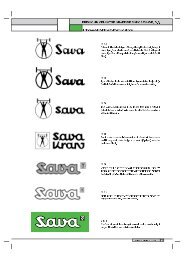Annual report 2005 - Sava dd
Annual report 2005 - Sava dd
Annual report 2005 - Sava dd
Create successful ePaper yourself
Turn your PDF publications into a flip-book with our unique Google optimized e-Paper software.
a n n u a l r e p o r t | 2 0 0 5<br />
1 9 6 |<br />
Segment <strong>report</strong>ing<br />
<strong>Sava</strong> d.d. has not defined either business or geographical<br />
segments.<br />
Exchange rate and conversion method<br />
in domestic currency<br />
All of the items shown in the accounts books and<br />
expressed in foreign currency are converted to the tolar<br />
value at the medium exchange rate of the Bank of<br />
Slovenia as valid on the last day of the accounting<br />
period.<br />
Intangible long-term fixed assets<br />
Intangible long-term fixed assets include investments in<br />
the acquired long-term rights on industrial property.<br />
An intangible long-term fixed asset is initially<br />
recognised at cost. Cost includes also the import and<br />
non-refundable purchasing taxes. Cost does not include<br />
the interests accrued by the appearance of an intangible<br />
long-term asset.<br />
Due to its increase in value the intangible long-term<br />
fixed assets are not revalued. The mentioned method<br />
applies also to intangible fixed assets that are purchased<br />
abroad.<br />
If the book value exceeds the substitutable value, the<br />
value in intangible fixed assets will impair. The<br />
substitutable value is determined on the basis of revenue<br />
and expenses estimation, which arise from further use of<br />
the assets considering thereby a suitable discount rate in<br />
future cash flows.<br />
Tangible fixed assets<br />
At initial recognition a tangible fixed assets is valued at<br />
cost. The cost includes its purchase expense, import and<br />
non-refundable purchasing taxes and expenses which<br />
can be attributed directly to its putting in service for the<br />
intended use, especially expenses for its transport and<br />
installation.<br />
Costs do not increase the interests on loans for acquiring<br />
a tangible fixed asset until it is put in service for the use.<br />
The cost of a tangible fixed asset, which is constructed<br />
or manufactured in the company, comprises expenses<br />
that are caused by its construction or manufacturing and<br />
indirect expenses for its construction or manufacturing<br />
that can be attributed to it.<br />
Due to the increase in value the tangible fixed assets are<br />
not revalued; the effects of the impairment are shown in<br />
operating expenses from revaluation.<br />
The difference between the net sales value and the book<br />
value of a disposed fixed asset is transferred under the<br />
operating revenues from revaluation, if the former is<br />
higher than the latter and under the operating expenses<br />
from revaluation, if the latter is higher than the former,<br />
respectively.<br />
Expenses that arise later in relation to a tangible fixed<br />
asset, increase its cost value, if they increase its future<br />
benefits in comparison with the ones originally<br />
estimated. The expenses that assure the prolongation of<br />
serviceability period of the tangible fixed asset first<br />
decrease the depreciation adjustment of its value<br />
calculated by then.<br />
Repairs of or maintaining the tangible fixed assets are<br />
intended for renewing or preserving the future economic<br />
benefits expected on the basis of the originally estimated<br />
level of asset efficiency. They are recognised as<br />
expenses upon their appearance.<br />
Depreciation<br />
The value of a tangible fixed asset and intangible fixed<br />
asset that is not written off is decreased through<br />
depreciation.<br />
The tangible fixed asset starts to be depreciated on the<br />
first day of the next month after beginning of use and<br />
performing the activity, for which it is intended,<br />
respectively.<br />
The intangible fixed asset starts to be depreciated when<br />
it is available for use.<br />
The decrease in value of depreciable assets due to an<br />
impairment are not depreciation costs but operating<br />
expense from revaluation of depreciable assets, except if<br />
at its precedent increase in value the equity revaluation<br />
adjustment was enhanced. In such a case it should be<br />
used before it increases the operating expenses from<br />
revaluation of these assets.








